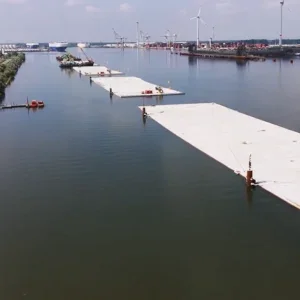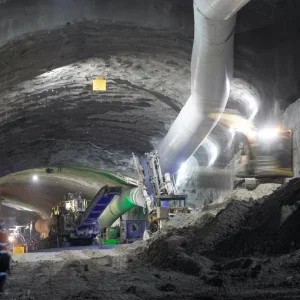President Biden’s US$1.2 trillion infrastructure spending plan, passed by the US Senate in August, will give a welcome leg-up to improving the US’s transport and utilities networks, and no doubt provide work for the tunnelling industry.
Among the projects that may benefit from the Infrastructure Investment and Jobs Act is the long-delayed Hudson rail tunnel connecting New York and New Jersey.
But while industry waits to see where the money will be spent, there are plenty of projects underway, and many of them are upgrading water and wastewater systems in Canada and the US.
Among them is the five-mile Mill Creek drainage relief tunnel in Dallas which is setting records for the US tunnel industry. The Robbins main beam TBM, named Big Tex, is the largest hard-rock TBM ever to bore in the US, and the first dual-diameter machine.
Earlier this year, Southland/Mole Joint Venture successfully made the conversion from 11.6m to 9.9m at 1.8 miles into the bore. The two sizes were required because of the different flow rates for the upstream and downstream sections of the tunnel.
To achieve the conversion, the TBM features a specialised cutterhead with removable spacers and adjustable bucket lips.
Deep below Lake Ontario, contractor Southland Holdings has also set a Toronto city record with progress on the 2.2-mile Ashbridges Bay Outfall tunnel using a Robbins single shield TBM. The crew completed 30 rings in a day, equating to 45m. The project is anticipated to be Canada’s largest wastewater outfall.
CLEARWATER PROJECT
In late September, tunnelling was due to begin on the Clearwater Project, a new seven-mile tunnel for the Los Angeles County Sanitation District. Construction on the project, which addresses ageing infrastructure that falls short of current seismic standards, began in 2019. Tunnelling is expected to be completed in early 2025 and the project is scheduled to finish in 2027.
The Herrenknecht slurry TBM, named Rachel, has been equipped to deal with the varied geological conditions along the length of the tunnel and the two distinct geological settings at each end.
“The northern section is predominantly silts, sands, clays and gravels encompassing the Lakewood Formation and San Pedro Sands soil groups,” says Russ Vakharia, the District’s construction manager for the project. “The southern section is a predominantly ‘weak rock’ group with varied layers of siltstone, dolomite, claystone sandstone and less amounts of basalt that is characterised as ‘hard rock’.
Vakharia adds: “The varied lithologies specific to the rock portion may create unbalanced loading during excavation. Additionally, consistent with many portions of the Los Angeles area, the alignment has been classified as ‘gassy’.”
The tunnel has more than 30 curves and will be excavated from a single shaft; there will be no intermediate shafts.
To add to the complexity, two fault zones – the Palos Verdes and the Cabrillo – transverse the alignment, and in the southern rock there are water pressures of up to 10bar, an overburden of more than 122m and squeezing ground conditions.
To mitigate these challenges, the TBM has been fitted with several features, including six large filter presses that augment the slurry treatment plant to handle fines separation from the slurry mixture. For the southern rock portion, the TBM can provide additional thrust capacity (up to 135MN), and has a tapered shield, equipment designed to operate at up to 10bar pressure, instrumentation and equipment to monitor and measure rock convergence, as well as the means to consolidate the ground ahead of the TBM.
Multi-service vehicles will carry up to two tunnel segment rings, personnel and other equipment through the tunnel, while multiple slurry booster pumps will manage the supply and discharge flows.
Vakharia states that the majority of the northern portion would be post-tensioned to handle internal pressures once the tunnel is in service.
“As most of the post tensioning will be conducted concurrent with mining, two integrated work platform gantries are included in the TBM trailing gear. Within these work platforms, the post-tensioning strands will be threaded through the segment ducts, tensioned and grouted. Due to the additional support features required, the total tunnel-machine length is close to 800ft (244m),” says Vakharia.
The lining is a single-pass 18ft (5.48m) ID and 20ft (6.1m) OD, six-piece precast segmental lining. In several sections, including the fault zones, a secondary steel lining will be installed.
“Since this is an effluent outfall tunnel, which can encounter internal pressures during operation and varying native ground support along the alignment, different types of precast tunnel lining reinforcement will be used. This includes combinations of fibre reinforcement and steel rebar reinforcement, and different types of post-tensioned configurations. The concrete strength of the segments also varies in the southern and northern portions of the alignment,” explains Vakharia.
DIGINDY TUNNEL SYSTEM
In Indianapolis, the US$2bn, 45km-long DigIndy Tunnel System is nearing completion. Excavation has finished on five of the six, 5.48m-diameter tunnels which are designed to reduce combined sewer overflows (CSOs), and the sixth – the 11.8km-long Pleasant Run tunnel – is around 20% complete.
DEEP ROCK TUNNELS IN ST LOUIS
In Missouri, the Metropolitan St Louis Sewer District (MSD) is building eight, mainly deep rock tunnels and storage facilities as part of MSD Project Clear, a US$6bn, 28-year programme to improve water quality and wastewater management.
Excavation of the 6.2km-long Deer Creek tunnel was completed in January 2020 and now the next two tunnels – Jefferson Barracks and Lower Meramec – are under construction.
Tunnelling of Jefferson Barracks was suspended in September 2019 when the 3.35m-diameter Robbins main beam TBM, which had mined around 2km of the 5.39km tunnel, encountered a karst feature.
“The tunnel is located in limestone bedrock. Karst was identified as the most important geotechnical issue as the bluffs along the western side of the Mississippi River are riddled with caves and karstic crevices,” says Allen Muehlher, assistant director of engineering.
The TBM was recovered in late July this year after a 205ft (62.5m)-deep recovery shaft was built and a 200ft (61m) tunnel was hand-mined back to the TBM. A replacement TBM is now being prepared.
“A 13.5ft (4.1m)-diameter TBM with the capability of probing and grouting through its face is currently being refurbished by Robbins,” says Muehlher. Tunnelling is expected to resume in January 2022 with completion scheduled for July.
In addition to the launch and retrieval shaft, there are 14 bored shafts for drop pipes, vent pipes and fibre-optic conduits. “These shafts passed through a karstic zone located below the level of the Mississippi River but above the tunnel so they were blind bored,” says Muehlher.
MORE PROJECT CLEAR
The next tunnel in Project Clear is the 10.9km Lower Meramec. The contractor is currently excavating the starter tunnel, drilling the drop and vent shafts, and installing the secant pile excavation system for the TBM retrieval shaft. Tunnelling is expected to be completed sometime in early 2025 and details of the TBM have not yet been finalised.
Deer Creek was lined with a 12in-thick (304mm) cast in situ concrete liner. Jefferson Barracks will have an 84in (2.13m) glass fibre-reinforced thermosetting resin sewer pipe with cellular concrete placed to fill the annulus between the pipe and the tunnel sidewall, while the Lower Meramec will have a 96in (2.44m) glass fibre-reinforced thermosetting resin sewer pipe.
Other excavations for Project Clear include the largest – the 14.4km, 30ft (9.1m)-diameter Lower and Middle River Des Peres storage tunnel, which will start in 2027; the three-mile River Des Peres Tributaries CSO tunnel; and the 3.2km, 22ft (6.7m)-diameter Upper River Des Peres CSO storage tunnel, which is due to start in 2032.
In Seattle, Webuild Group’s US subsidiary, Lane, began excavating the 4.2km, 5.5m-diameter storage tunnel for the Ship Canal Water Quality Project in June. The tunnel will prevent up to 75 million gallons (284m lit) of CSOs from flowing into the Lake Washington Ship Canal, Salmon Bay and Lake Union every year.
SECOND NARROWS WATER SUPPLY TUNNEL
Further north, Metro Vancouver is undertaking five water supply tunnels that will meet current seismic standards. Excavation on the 1.1km-long Second Narrows tunnel, under Burrard Inlet was completed in early October 2021 (see box). Meanwhile, work on the 2.3km Annacis Water Supply Tunnel, which will run under the Fraser River, and the 1.4km Stanley Park Water Supply tunnel, is due to start in 2022. See box below for further information.
OTHER PROJECTS, TOO
Water projects may currently be in abundance but other sector projects are also in progress or planned.
In Toronto, a US$32.1bn subway expansion, said to be the largest transit expansion in Canadian history, is under way. In June, a ground-breaking ceremony was held for the 7.8km Scarborough Subway Extension. Strabag has been awarded the contract, which also includes supplying the TBM. Meanwhile, West Connectors has been awarded the contract for the 9.2km Eglinton Crosstown West Extension, which includes 6km of tunnelling. Boring on this project is due to start in spring/summer 2022.
Trans Mountain Corporation, which operates Canada’s only pipeline system transporting oil products to the West Coast, is boosting capacity with the Trans Mountain Expansion Project. The scheme includes a 2.6km tunnel to house three 30in (762mm) delivery pipelines, connecting the Burnaby and Westbridge Marine terminals.
Excavation of the 4.43m-diameter tunnel began in May and is expected to proceed at 15m per day. The Herrenknecht dual-mode TBM can be changed from EPB shield mode to an open-mode configuration. This will accommodate the wide variety of geotechnical features, and the sudden change in geotechnical conditions.
Nearby, a new eight-lane immersed-tube tunnel is planned to replace the George Massey Tunnel on Highway 99, south of Vancouver. The US$3.25bn project is scheduled to open in 2030.
And there is also Elon Musk’s penchant for ‘Boring Loops’. The latest are Florida’s Las Olas Loop, a 4km, bidirectional tunnel which will carry passengers in Teslas from downtown Fort Lauderdale to the beach; and the Ontario Airport Loop, for which The Boring Company has also suggested a bi-directional system.







